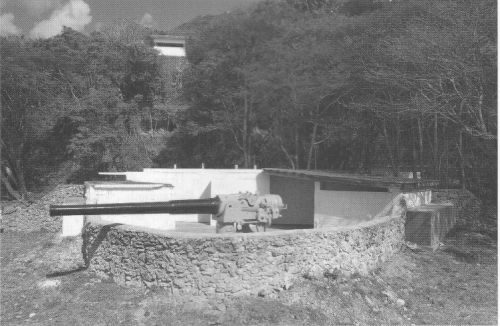- Author
- Swinden, Greg
- Subjects
- History - WW2
- Tags
-
- RAN Ships
- HMAS Kanimbla II
- Publication
- September 2002 edition of the Naval Historical Review (all rights reserved)
During their recent Indian ocean deployment on anti-illegal immigration duties, members of the ship’s company of HMAS Kanimbla helped in the restoration of the WW II coastal defence emplacement on Christmas Island. It will eventually become a museum and tourist attraction.

A significant piece of Australia’s military history is now in better shape thanks to the men and women of HMAS Kanimbla. While operating near Christmas Island during the ship’s recent Operation RELEX II deployment, several sailors and soldiers from Kanimbla’s ship’s company expended much blood and sweat to refurbish a 6-inch gun emplacement and observation post which overlooks Flying Fish Cove.
The 6-inch gun was made in 1900 and installed at Christmas Island in late 1940. It was manned by men from the Royal Artillery who made up part of the island’s garrison. Christmas Island was, and still is, a large supplier of phosphates for the Australian and South East Asian agricultural market and with the potential threat of war with Japan the island’s defences were increased. In February 1942 a Japanese submarine sank a phosphate carrying vessel off the island and the gun was fired in anger in an attempt to sink the submarine.
In March 1942 the Japanese invaded Christmas Island. The majority of the island’s garrison was made up of Indian Army troops who refused to fight the Japanese. Several of these men rose up in a mutiny against the British troops on the island and murdered them, before surrendering to the invading Japanese. The five Royal Artillery men manning the 6-inch gun near Flying Fish Cove were amongst those killed and their bodies were dumped over the nearby cliffs into the sea.
Following the end of World War II the gun fell into disrepair. In 1983 a major restoration of the gun emplacement was undertaken. When the site was visited in July this year, however, it was found that the ravages of time had taken their toll, with the gun showing substantial weathering, and the emplacement and observation post were overgrown with trees and weeds.
An offer was made to the Christmas Island Shire Council to refurbish the gun emplacement site and this was eagerly accepted by the Council’s Chief Engineer, Mr Gary Dunt (ex RAN WOETC) and the Island Administrator, CDRE Bill Taylor, RAN Retired.
Kanimbla s volunteer working parties, comprising both Navy and embarked Army personnel, turned to and stripped the gun of its layers of rust, repainted it and the emplacement’s external walls, removing 20 years’ worth of dust, rubble, weeds and trees in the process. The trees surrounding the observation post were cut down, as were 50 metres of thick vegetation on the seaward side of the gun, to allow both to be more visible to visitors to the island. Some concreting was also undertaken to strengthen the emplacement.
The Christmas Island Shire Council provided most of the tools, concrete and paint for the venture, with Kanimbla supplying the muscle. The refurbishment took place over several weekends with groups of sailors and soldiers voluntarily giving their own time to ensure that this important part of the island’s history remains intact and in good condition. The site will become part of the Christmas Island Museum, linked to the nearby Colonial Administrator’s House, which is also being refurbished and due to be opened as a Museum in September 2002.




